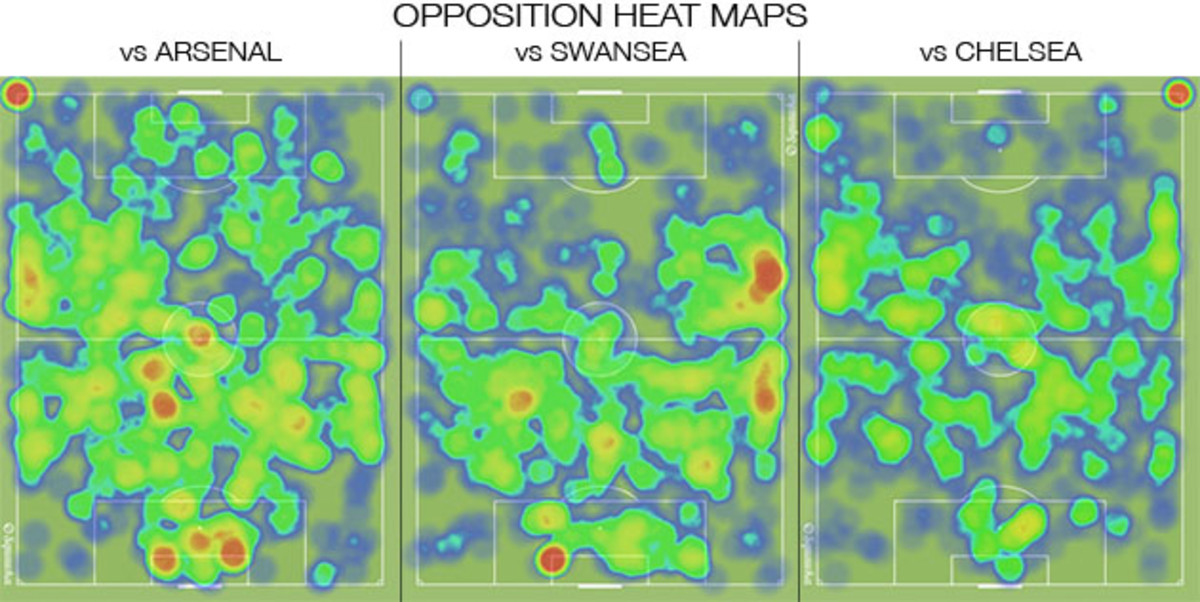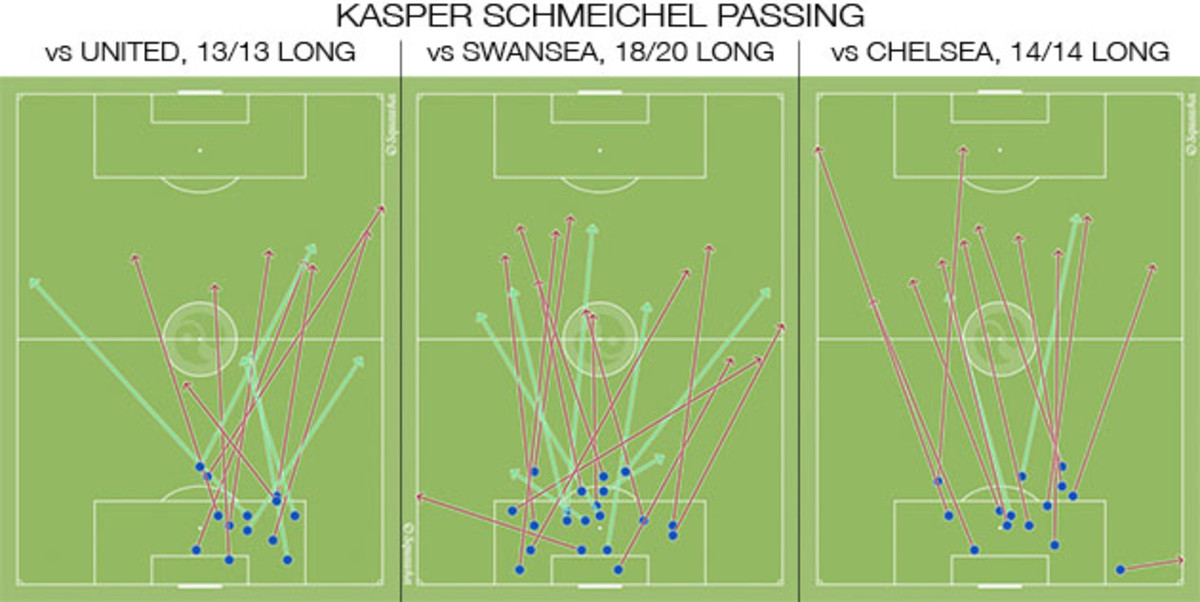Tactical breakdown: How Ranieri's Leicester City has overtaken the EPL

Leicester City sits on top of the Premier League table after 16 rounds in one of Europe’s biggest stories nearly halfway through the season. New manager Claudio Ranieri has sharpened Leicester’s focus, harnessing his players’ scrappiness to become a formidable defensive side paired with England’s in-form striker, Jamie Vardy.
Unlike its results, the team’s tactics are fairly typical. The Foxes line up in a standard English 4-4-2, with Riyad Mahrez’s tendency to drift inside and next to the front two passing as their most complicated wrinkle.
When Ranieri came in, he insisted that he didn’t “want to change too much but just give the Italian tactical way” to his new players. The notion of classic Italian tactics conjures mental images of catenaccio and a devotion to defense at expense of all other phases of play, but Ranieri’s approach is a bit more advanced than that.

Watch: Leicester's Vardy, Mahrez score great goals in win vs. Chelsea
This Leicester team seem highly influenced by the legendary Arrigo Sacchi, who jettisoned man-marking and the libero in favor of a flat back four that defends zonally. His AC Milan teams were pressing machines, playing out of a 4-4-2 in which the highest players chased opponents in their own half and made it difficult to penetrate the lines separating them from goal.
Ranieri drew high praise from the master himself during the 2011-12 season.
He took over an Inter Milan team lingering just above the relegation zone and rose as high as fourth, and Sacchi commended Ranieri for his efforts in organizing and motivating the squad. After a poor run of results in the spring, though, Ranieri left Inter by mutual consent.

Sacchi wanted a maximum of 25 yards between his defenders and forwards and a high line that would compress the playable area of the pitch to his team’s advantage. Out of possession, the current Leicester displays similar tendencies, leaving little space for opponents to play centrally.
As the opposition builds out of the back, wingers Mahrez and Marc Albrighton pinch in toward the middle, enticing wide play. Once the ball moves left or right, the near-side forward and winger can close down and win the ball back or force a long ball that Leicester’s defenders can win.
Newcastle clears relegation zone, Spurs blow opportunity, more EPL
As necessary, the fullbacks will step to prevent players from turning with the ball in midfield, and it’s not out of character for center backs Robert Huth and Wes Morgan to follow checking runners into the middle block because the team’s compactness means they’re never far away.
If the ball does find a central gap, the receiving attacker will often be met with a strong tackle.
The Foxes squeeze the available attacking space and tend to leave opponents frustrated, even when the numbers would suggest that they should be outnumbered in the middle. Leicester can play with two central midfielders against the 4-3-3 and 4-2-3-1 systems of the modern game and still keep opponents out of dangerous areas because of the concentration of numbers.
With how close Leicester’s players sit in their defensive starting positions, opponents have to break down three lines of pressure in quick succession to get behind without hitting a ball over the top. If they go long, the back line is usually high enough to catch a forward offside, or goalkeeper Kasper Schmeichel can easily deal with overhit passes.

It’s a simple system, but considering the players’ high-energy approach in attack, the defensive discipline Ranieri has instilled is impressive. Teams struggle to find the ball centrally in the attacking half, and Leicester’s one defeat this season was the result of chances conceded in wide areas.
In that 5-2 loss to Arsenal on Sept. 29, it was left winger Alexis Sánchez’s excellence that undid Leicester. Others, including Swansea City and Chelsea in the last two rounds, struggled to generate any opportunities.
Vardy chases from the front, N’Golo Kanté and Danny Drinkwater protect the middle and all four in the back are comfortable defending one-on-one if the ball gets that far. The midfielders hold their line of confrontation right around the halfway line, marking opponents and cutting off passing lanes to induce long balls.
Once it wins the ball—Leicester has a league-high 357 interceptions, indicative of its pressing ability—the club tries to get forward as quickly as possible. That often includes going wide to Albrighton or an overlapping fullback, or looking for a diagonal ball over the top from central midfield to Mahrez as he cuts inside.

Schmeichel almost always looks long out of the back. In the last three matches, only two of the passes he attempted weren’t long. His passing percentage is poor, but Leicester prefers having the ball far away from its goal so it can press high.
Flawed EPL favorites leading to congested table, fascinating title race
This isn’t a team designed to control the majority of possession. In a 3-2 win over West Bromwich Albion on Halloween, Leicester kept 52% of the ball; that’s the only time it has had more than 50% this season.
An average of 46% possession is 18th in the league, and Leicester’s 72% passing accuracy sits dead last. The Foxes have also attempted the second-fewest total passes among the Premier League’s 20 clubs.
Instead, what Leicester has is one of the most clinical forwards in Europe so far this season and an ability to spring attacking players quickly after regaining possession. The ball rarely stays centrally for very long before whoever is on it looks for a diagonal penetrative ball or at least a wide option.

Even on the counterattack, Leicester rarely finds itself with a numerical advantage. Even numbers is about as good as it gets, but that hasn’t been necessary with Vardy’s execution. He has taken 59 total shots, finding the target with 37 of them and scoring 15 goals—meaning 41% of his shots on goal have ended up in the back of the net.
The biggest question surrounding Vardy and his club is whether the crazy run of form with which they began the season is sustainable. It seems unlikely to carry on through May, although no team has finished outside the top four in the Premier League after being top following 16 matches.
Ranieri himself sees the danger. A crowded holiday calendar awaits, which will see the Foxes play three more times before the New Year and then four games in two weeks after Jan. 1, all with a shallow squad in which only 16 players have made five or more league appearances this season.
“We need another five points—don’t laugh,” Ranieri said after Leicester’s 2-1 win over Chelsea on Monday, referring to the target that most relegation-threatened sides aim for to secure safety. “Let me achieve 40 points, then I’ll think about the next goal.”
Leicester’s only loss showed what could be coming. The Foxes defended lethargically in the second half against Arsenal, conceding three goals in a heavy loss, and couldn’t stop the Gunners from building out of the back or through midfield.
It would be disastrous later in the season, once players tire and begin to pick up injuries such as Drinkwater’s hamstring concern this week, if Leicester can’t play with the same energy that has taken it to the top. A Europa League finish, maybe even a Champions League place, doesn’t seem out of the question thanks to the quick start, but it will be very difficult to maintain the current pace of earning more than two points per match in the standings.
